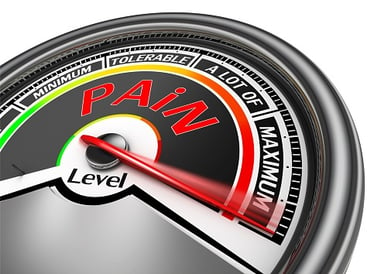 Think about a time you were in real pain. Not just a stub-your-toe or burn-your-hand-on the-stove kind of pain, but real, excruciating, all-encompassing pain. Maybe it was childbirth. Maybe it was a sports injury. But it was the kind of pain where you can’t think of anything else but the pain.
Think about a time you were in real pain. Not just a stub-your-toe or burn-your-hand-on the-stove kind of pain, but real, excruciating, all-encompassing pain. Maybe it was childbirth. Maybe it was a sports injury. But it was the kind of pain where you can’t think of anything else but the pain.
Now think of a lesser, mild pain. Maybe you get frequent headaches sitting at your desk all day or you can’t remember the last time you got a good night’s sleep because of that pinched nerve in your back. You’re reminded of this pain day-in and day-out.
You fall asleep in pain. You wake up in pain. Every time you stand up to get a drink of water or sit down to watch your favorite TV show, you feel the pain. Every move you make, you’re in pain and it’s starting to sabotage your life. What is going on and how can you find relief?
What is Chronic Pain?
Approximately 100 million Americans suffer from chronic pain, defined as pain that lasts for longer than six months. It can be excruciating or mild, occasional or continuous, uncomfortable or debilitating. Unfortunately, it may not be easy to identify the exact cause of the pain.
The pain may be associated with connective tissue disease – this refers to a group of disorders involving the protein-rich tissue that supports organs and other parts of the body, such as fat, bone, and cartilage. There are more than 200 disorders that affect the connective tissue.
The pain lasts longer than the normal healing period for an acute injury or disease – an acute injury or disease can be anything with a severe and sudden onset, such as a broken bone or asthma attack. If pain continues well-after the expected healing time or treatment, then it may be chronic.
The pain may not respond to standard routine pain medications – Just like Neosporin and a Band-Aid won’t help a cut if you actually need stitches, standard or over-the-counter pain medications like ibuprofen or acetaminophen won’t help your pain if there is an underlying issue or the pain keeps returning.
Some general examples of chronic pain are:
- Persistent low back pain
- Joint pain associated with arthritis or injury
- Headaches
- Nerve damage (pain that is coming from damaged diseased nerves)
- Tendinitis
- Sinus pain
- Carpal tunnel syndrome
- Pain affecting specific parts of the body (such as shoulders, hips, neck, etc.)
- Psychogenic pain (pain which starts out in our mind without a known cause)
Symptoms of chronic pain may include:
- Mild to severe pain that doesn’t go away
- Pain that is shooting, burning or aching
- Discomfort, soreness, tightness or stiffness
There can also be other problems associated with the chronic pain:
- Fatigue
- Sleeplessness
- Lethargy
- Withdrawal from activity
- Weakened immune system
- Changes in mood – hopelessness, fear, depression, irritability
- Anxiety
- Stress
Emotional Toll of Chronic Pain
When you’re consistently in pain and experience the issues associated with it, a complex interaction can take place that takes an emotional toll on your entire being.
Negative feelings can leave you feeling helpless, senseless or even ashamed for not being able to control these feelings. There is a mind-body link associated with chronic pain and effective treatment requires addressing both the psychological and physical aspects. Counseling and some types of therapy may help, but ultimately the support from friends and family and being proactive by visiting a qualified and trustworthy healthcare provider, is the best course of action to take.
Breaking the Cycle of Chronic Pain
The best possible way to handle chronic concerns is by taking action. Be your own advocate and stat by approaching your primary care provider (PCP) with your concerns and symptoms. It’s your PCP’s responsibility to provide you with appropriate education, diagnosis, pain medication and refills to manage your chronic pain issues.
There is only so much you can do on your own to manage the pain. The important thing to know is that you don’t have to live with chronic pain – there's help available at Orchard Hospital.
At Orchard Hospital, our healthcare professionals are committed to providing the finest medical care to Butte County and Northern California residents in a safe, friendly, and compassionate environment. When you are a patient at our hospital, our primary concern is to help you get well quickly and make a smooth transition home.
Because there have been increasing problems of narcotic dependency and accidental overdose both locally and nationally, all of the physicians at Orchard Hospital Emergency Department have established the following practice for those who suffer from chronic or recurrent pain:
- This practice applies to those who seek medical care in the Emergency Department four or more times in 1 year or 2 or more times in 4 weeks
- Are present from out of town for chronic or recurrent painful conditions such as migraine headaches, tooth pain, back or other musculoskeletal pain, cyclic vomiting syndrome, or other types of chronic or recurrent pain.
- Those who are receiving regular prescriptions for narcotic pain relievers from their primary care provider
For these types of conditions, our current practice will not order or write prescriptions for the following medications:
- Codeine
- Demerol
- Dilaudid
- Fentanyl Patches
- Hydrocodone
- Morphine
- Nubain
- Oxycodone
- Soma
- Stadol
- Other schedule II or schedule III narcotics
If you’re visiting the Emergency Department and are suffering from frequent chronic pain issues, we’ll offer an evaluation of your condition and provide you with a non-narcotic pain medication as therapy. Narcotic therapy, prescriptions or refills will not be issued by the Emergency Department Providers for chronic pain issues, and it’s your responsibility to seek this therapy, prescription and/or refill from your Primary Care Provider.
If you’ve lost their narcotics prescription, prescription is stolen, or have run out early, we will not be able to supply a new prescription for narcotic pain medication.
Other non-narcotic pain relievers will be offered (ex: Tylenol, Ibuprofen, Toradol, Phenergan, Compazine, Reglan, Benadryl, Haldol, Imitrex, Neurontin, etc.).
It’s your responsibility, as the patient, to prepare a treatment plan for breakthrough pain with your pain medicine provider. This plan should seldom include an ED for narcotics. If such is necessary, it's the patient’s responsibility to have their PCP contact the Emergency Department prior to the visit.
We strive to provide an extraordinary level of care, including compassion, knowledge and skill for critically ill and injured adults and children. Our mission in the Emergency Department is to provide outstanding, compassionate, family oriented care to our community in a timely manner.
Our staff is proud to serve the community of Biggs, Gridley, Live Oak, Oroville, Yuba City, Marysville, and Chico.



